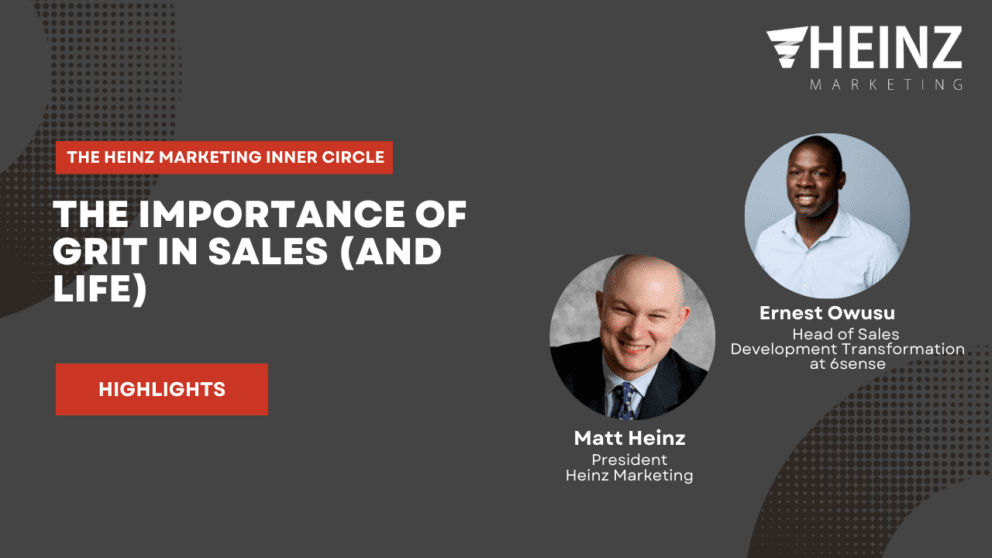When One Buying Committee Just Isn’t Enough

Summary
Discover the key to building a flexible buying committee that adapts to diverse customer profiles. Explore the challenges of selecting the right stakeholders and offers insights on including both technical and business decision makers. Learn how to customize the committee for specific verticals and use cases so you can enhance your sales efforts by refining and expanding your buying committee for increased success.
By Sarah Threet, Marketing Consultant
You’re building your buying committee based off your ideal customer profile, but you’re feeling stuck… What if one buying committee doesn’t feel all-encompassing of who has been reported to you by your sales department? Maybe it feels like the committee you have drafted doesn’t address all of the nuanced details of the kinds of accounts your SDRs interact with the most? Maybe it’s really a case-by-case situation? What if your product or service addresses multiple verticals? What if your product/service addresses multiple use cases that different personas and different verticals might care about for different reasons?
Sometimes it is just not as simple as developing one or even two buying committees. This blog will guide you on how to build the skeleton of a flexible and more nuanced committee.
Quick BC Recap
First, if you are unfamiliar with how to put together a basic buying committee and the components of such, please read our Senior Marketing Consultant, Win’s post on Persona Classification and the Buying Committee.
A quick recap of persona definitions:
- A Decision-Maker is someone who holds the power to say “yes” to a purchase. Decision Makers are divided into two subgroups: Business Decision Makers (BDMs) and Technical Decision Makers (TDMs).
- BDMs make decisions that affect the overall direction of a company. They are usually executives or managers who have a broad understanding of the company’s goals and objectives. They base their decisions on factors such as market trends, financial performance, strategic growth, and customer needs.
- TDMs make decisions related to technology. They are usually IT professionals who have a deep understanding of the company’s technology infrastructure and systems. They make decisions based on factors such as system performance, security, and scalability.
- A Validator is someone who holds the power to say “no” to a purchase. These folks are typically Finance, Procurement, Legal, or someone Technical like Security (Compliance).
- An Influencer is usually someone with low power in the buying decision making process, but who is a user of the product/service and relies on its performance and efficiency for their work.
- A Champion is the person who acts in the buying process but does not have the power to say yes. They are usually a Manager of the User Influencers who have a high stake in the performance of the product or service they would be purchasing.
TDM of Many Hats: When is the Technical Decision Maker also the Business Decision Maker?
Perhaps you are a company who provides a SaaS and you’re asking yourself how you would differentiate a TDM from a BDM? (or even maybe from a Validator!). Maybe your service addresses security and compliance issues that both a Validator and TDM would care about, AND in addressing those technical needs, your service makes it easier for your prospect’s company to grow strategically and meet customer needs.
Here are a few scenarios wherein a TDM might take on the role of a business decision maker in a buying committee:
- Small or medium-sized businesses: In smaller organizations, there might not be a dedicated BDM or executive solely responsible for procurement decisions. In these cases, the TDM, who has a strong understanding of both the technical requirements and the business needs, may assume the responsibility of making purchasing decisions.
- Specialized technical products or services: For complex technical products or services that require specific expertise, TDMs often possess the necessary knowledge and insight to understand the implications for the business. They may have a deeper understanding of the technology landscape and can make informed decisions that align with the organization’s goals.
- Highly technical industries: In industries that heavily rely on technical expertise, such as software development, engineering, or scientific research, technical professionals often have a deep understanding of the business implications of their decisions. Their expertise extends beyond technical considerations, and they are well-versed in the market, competition, and the impact of their choices on the organization.
- Limited BDM availability: In some cases, the typical BDM may be unavailable or not actively involved in the buying committee due to other commitments. In these situations, the typical BDM may entrust the TDM with the dual role of evaluating technical aspects and ensuring that the purchase aligns with the organization’s overall objectives.
It’s important to note that while the TDM can assume the BDM’s role in specific situations, it is generally advantageous to involve both technical and business decision makers to ensure a holistic evaluation of the purchase, encompassing both technical feasibility and alignment with the organization’s strategic goals.
Case by Case Example
Once again, let’s say you have a SaaS that you are trying to pitch to your accounts. Your ICP is broad and encompasses multiple verticals; maybe one vertical is Marketing Technology and the other is Financial Technology – how does the buying committee differ between those two verticals?
First, begin by defining your base buying committee. Who are the main personas Sales speaks with most? Who resonates most with messaging? Who seems to push closed deals most often? You might not yet have this data and may need to make your best guess, both through market research and by gathering information from your Sales team. If you have the resources to track these metrics, ensure that your Sales team commits to filling out as much account information as possible so that you can make strategic changes to your buying committee in the future when you have more data.
Your base buying committee may even have a couple of variations dependent on account type/size – think smaller companies with C-Suite titles versus larger companies with Director titles. Here is an example of a base buying committee to work upon:
- BDM: Customer Success Director, Director of Operations
- TDM: Director of IT, Product Director
- Champion: Product Manager, Account Manager
- User Influencer: DevOps Engineer, Customer Service Manager
- Validator: Compliance, Procurement, Finance, or Information Security Manager
Now, modify the BC by its verticals. Who might be added, removed, or moved around depending on the industry?
MarTech:
- BDM: Customer Success Director, Director of Operations, Director of Marketing Operations
- TDM: Director of IT, Product Director
- Champion: Product Manager, Account Manager, Marketing Campaign Manager
- User Influencer: DevOps Engineer, Customer Service Manager, Marketing Automation Specialist
- Validator: Compliance, Procurement, Finance, or Information Security Manager
FinTech:
- BDM: Customer Success Director, Director of Operations, Director of Finance
- TDM: Director of IT, Product Director, Director of Security
- Champion: Product Manager, Account Manager
- User Influencer: DevOps Engineer, Security Engineer, Infrastructure Engineer, FinOps Engineer
- Validator: Compliance, Procurement, Finance, or Information Security Manager
Note the bolded industry-specific additions to the base BC. In the case of FinTech, where security and compliance are huge needs and financial professionals are going to have a holistic understanding of financial business processes, financial professionals may be BDMs rather than just Validators, and security professionals may be TDMs rather than just Validators.
You can continue to build a more specific and nuanced BC off of these industry BCs or off of the base BC for specific use cases as well. Different personas are going to have different needs from your product/service, so depending on the use case, you may have unique personas show up as BDMs and TDMs.
In conclusion
Building a buying committee is not always a straightforward process, especially when dealing with complex products or services that cater to multiple verticals or use cases. While a basic buying committee framework exists, it is important to adapt and customize it to address the nuances of your target accounts. In some cases, a Technical Decision Maker (TDM) may also assume the role of a Business Decision Maker (BDM), particularly in smaller organizations, specialized technical industries, or when BDM availability is limited. However, it is generally beneficial to involve both technical and business decision makers to ensure a comprehensive evaluation of the purchase. Additionally, when tailoring the buying committee for specific verticals or use cases, it is crucial to identify the industry-specific personas and their roles within the committee. By continuously refining and expanding your buying committee, you can effectively engage with various stakeholders and increase the chances of success in your sales efforts.
For further assistance on tailoring your Buying Committee, contact us or send an email to acceleration@heinzmarketing.com.





